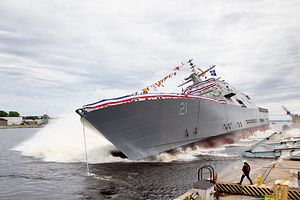The U.S. Navy has launched the future littoral combat ship (LCS) USS Minneapolis-Saint Paul (LCS 21) during a ceremony at the Fincantieri Marinette Marine (FMM) shipyard in Marinette, Wisconsin, on June 15.
The launch of the Minneapolis-Saint Paul–the Navy’s 21st LCS overall and the 11th of the Freedom variant—was preceded by a christening ceremony headed by the ship’s sponsor, Jodi J. Greene, Deputy Under Secretary of the U.S. Navy for Policy.
“LCS is the second largest ship class in the U.S. Navy, and Lockheed Martin is proud to deliver capability and added force projection with each additional hull,”Joe DePietro, Lockheed Martin vice president and general manager of Small Combatants and Ship Systems, was quoted as saying, according to a Lockheed Martin press statement.
The LCS class consists of the Independence and Freedom variants. Construction of the Freedom variant is headed by Lockheed Martin at the FMM shipyard, whereas the building of Independence-class LCS is managed by Austal USA in Alabama. The Austal and Lockheed shipyards are each capable of building two LCS per year.
The builder of the Freedom-class Minneapolis-Saint Paul, Lockheed Martin, has delivered a total of eight LCSs to the Navy. In 2019, Lockheed Martin and Fincantieri Marinette Marine will kick off construction on two more ships, deliver two LCSs, complete sea trials for two ships and see three Freedom-class ships commissioned.
As I noted previously:
[W]ith 40 percent of the hull reconfigurable, both LCS variants use an open architecture design, enabling the warships to be fitted with interchangeable so-called mission packages providing capabilities for surface warfare (SUW), anti-submarine warfare (ASW), and mine countermeasures (MCM) missions in the littoral zone. The ASW warfare package is expected to become available to the fleet in 2019, while the MCM package will be available in 2020.
Next to to being armed with a 57-millimeter naval gun and a 11-cell Raytheon RIM-116B SeaRAM missile-defense system, the ships will also be fitted with the Surface-to-Surface Missile Module, a 24-shot AGM-114L Longbow Hellfire missile vertical launch system, with initial operational capability expected by the end of 2019.
As my colleague Steven Stashwick reported last month, Lockheed Martin is spearheading an effort to boost the combat capabilities of the ships in a two-phased plan.
“The first phase consists of adding the fifth-generation over-the-horizon Naval Strike Missile (NSM) to the LCS’ arsenal,” as I explained last week. “Norway-based Kongsberg Gruppen and U.S. missile maker Raytheon Company was selected by the U.S Navy to supply the new missile in June.”
Moreover, both LCS variants will receive “the Nulka decoy system help defend against advanced adversary anti-ship missiles, an improved electronic warfare suite, upgraded fire control systems for the ship’s 57-millimeter main gun, and possible radar upgrades,” according to Stashwick.

































